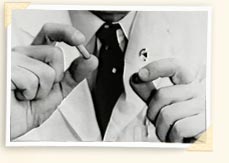 "Some of the new drugs are producing remarkable results... We can…successfully treat patients who, for ten or twenty years or even longer, resisted all other therapy and filled the back wards of mental hospitals as incurables." "Some of the new drugs are producing remarkable results... We can…successfully treat patients who, for ten or twenty years or even longer, resisted all other therapy and filled the back wards of mental hospitals as incurables."
— Heinz Lehmann, MD, 1960
Drug First Tested on Nurses
Eager to escape Nazi Germany, Heinz Lehmann, MD, immigrated to Canada and joined the Hospital in 1937. Fluent in German and French, he was able to read European medical journals that were inaccessible to most North American doctors. On one occasion, he read a reference to the drug chlorpromazine in a French research paper. Although the drug was originally intended to reduce surgical shock, it also seemed
to calm excited psychiatric patients. He decided to test it.
In those days, arranging a drug test was a simple affair. Heinz Lehmann asked nursing staff if they would take chlorpromazine as part of a medication trial. Those who agreed were given sedatives during their lunch hour, and asked to perform math and other tests. He repeated the exercise with chlorpromazine on another day. Although some of the nursing staff felt faint from low blood pressure, their performance scores were high. Heinz Lehmann also tried the drug on himself.
Life-Changing Results for Patients
In May 1953, a 16-year-old girl was admitted to the Hospital because she was hearing the voice of a schoolmate threatening to kill her. Heinz Lehmann arranged to have her treated with chlorpromazine. After three months, she was discharged and able to return to school. Heinz Lehmann also treated a male
patient with schizophrenia, who had a history of talking to himself and becoming excited for no apparent reason.
After three months, he was able to sit quietly, read a newspaper and talk coherently— for the first time since his admission 14 years earlier. By the end of 1953, 230 of the Douglas patients were being treated with chlorpromazine. By 1957, approximately 1,300 patients (80% of the population) were treated for psychosis with antipsychotics. News of his work spread throughout North America, causing a treatment revolution.
Reunions: Joyous and Bittersweet
Families and friends were astounded at the new-found "wellness" of their loved ones. While most were overjoyed, it did create some delicate situations. None more so than in cases where husbands of female
patients had divorced their wives and remarried, assuming that their wives would always be hospitalized. More than one woman gained her mental health only to find she had lost her husband.
 The “Dandelion Experiment” The “Dandelion Experiment”
In the 1950’s, most Douglas Hospital doctors, during this period, were living on the hospital grounds. One day, while walking from his house to his office, Heinz crossed a grassy field on which hundreds of dandelions grew. He picked some and placed them in glasses of water. To each glass he added a different drug: secobarbital, a barbiturate sedative; dextroamphetamine, a stimulant; chlorpromazine, the first of the new phenothiazine derivatives; prochlorperazine, another antipsychotic phenothiazine; imipramine, the new antidepressant; and, as a control, plain water.
The next day, under the influence of secobarbital, the petals of the dandelion remained tightly closed; the petals in the chlorpromazine and imipramine solutions opened slightly; the ones in the prochlorperazine solution were normally open, as were the controls; but the ones in the dextroamphetamine solution were more widely open than the normals. It confirmed that chlorpromazine was unlike the barbiturates, and that some of the phenothiazine derivatives had an even less sedating effect than chlorpromazine. What an ingenious experiment!
Second Discovery: Imipramine
In 1957, Heinz Lehmann again made medical history. He read in a Swiss medical journal that the drug imipramine seemed to lift depression. He had a sample air-mailed to the Hospital and patients were trying it within weeks of its arrival. In about two-thirds of cases, their depression partially or completely lifted within a month. After publishing these exciting results, imipramine became widely used throughout North
America.
|